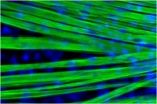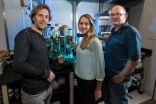(Press-News.org) High-dose vitamin D supplementation in postmenopausal women was not associated with beneficial effects on bone mineral density, muscle function, muscle mass or falls, according to the results of a randomized clinical trial published online by JAMA Internal Medicine.
Low levels of vitamin D contribute to osteoporosis because of decreased total fractional calcium absorption (TFCA) and nearly half of postmenopausal women sustain an osteoporotic fracture. However, experts disagree on the optimal vitamin D level for skeletal health. Some experts contend that optimal serum 25-hydroxyvitamin D levels are 30 ng/mL or greater, while the Institute of Medicine recommends levels of 20 ng/mL or greater, according to study background.
Karen E. Hansen, M.D., M.S., of the University of Wisconsin School of Medicine and Public Health, Madison, and colleagues compared the effects of placebo, low-dose cholecalciferol (a form of vitamin D) and high-dose cholecalciferol on one-year changes on total TFCA, bone mineral density, sit-to-stand tests and muscle mass in 230 postmenopausal women (75 or younger) with vitamin D insufficiency.
Trial participants were divided into three groups: daily white and twice monthly yellow placebo, daily 800 IU vitamin D3 (low dose) and twice monthly yellow placebo, and daily white placebo and twice monthly 50,000 IU vitamin D3 (high dose). The high-dose regimen vitamin D regimen achieved and maintained 25-hydroxyvitamin D levels at greater than or equal to 30 ng/mL.
Results indicate that calcium absorption increased 1 percent in the high-dose group but decreased 2 percent in the low-dose group and 1.3 percent in the placebo group. The small increase in the high-dose group did not translate into beneficial effects because authors found no difference between the three study groups for changes in spine, average total-hip, average femoral neck or total-body bone mineral density, trabecular bone score, muscle mass or sit-to-stand tests. There also were no differences between the groups for numbers of falls, number of fallers, physical activity or functional status.
The authors note few African-American women participated in the study, which limits its ability to detect differential responses to cholecalciferol based on race. The study results also cannot be used to guide cholecalciferol therapy for young adults, men, or women older than 75, according to the authors. They point out individuals only participated for one year and perhaps longer exposure to high-dose cholecalciferol might yield greater effects on bone mineral density.
"Study results do not justify the common and frequently touted practice of administering high-dose cholecalciferol to older adults to maintain serum 25(OH)D [25-hydroxyvitamin D] levels of 30 ng/mL or greater," the study concludes.
Editor's Note: How Much Vitamin D is Enough?
In a related Editor's Note, Deborah Grady, M.D., M.P.H., a deputy editor of JAMA Internal Medicine, writes: "It is possible that treatment beyond one year would result in better outcomes, but these data provide no support for use of higher-dose cholecalciferol replacement therapy or indeed any dose of cholecalciferol compared with placebo."
INFORMATION:
(JAMA Intern Med. Published online August 3, 2015. doi:10.1001/jamainternmed.2015.3874. Available pre-embargo to the media at http://media.jamanetwork.com.)
Editor's Note: This study was supported by a grant from the National Institute on Aging and a grant from the Office of Dietary Supplements. An author made a conflict of interest disclosure. Please see the article for additional information, including other authors, author contributions and affiliations, financial disclosures, funding and support, etc.
Media Advisory: To contact corresponding author Karen E. Hansen, M.D., M.S., call Emily Kumlien at 608-265-8199 or email EKumlien@uwhealth.org. To contact editor's note author Deborah Grady, M.D., M.P.H., email mediarelations@jamanetwork.org.
A recently discovered family of small RNA molecules, some of which have been implicated in cancer progression, has just gotten much larger thanks to a new RNA sequencing technique developed by researchers at UC Santa Cruz.
The technique, described in a paper published August 3 in Nature Methods, provides sensitive detection of small RNAs that are chemically modified (methylated) after being transcribed from the genome. The researchers used the technique to reveal an abundance of modified fragments derived from transfer RNA molecules in both yeast cells and human cells.
"Transfer ...
Skeletal muscle is one of the most abundant tissue types in the human body, but has proven difficult to produce in large quantities in the lab. Unlike other cell types, such as heart cells, neurons and cells found in the gut, previous attempts to efficiently and accurately derive muscle cells from pre-cursor cells or culture have not been fruitful. In a new study published this week in Nature Biotechnology, investigators from Brigham and Women's Hospital (BWH) report that by identifying and mimicking important developmental cues, they have been able to drive cells to grow ...
LA JOLLA--T cells are the guardians of our bodies: they constantly search for harmful invaders and diseased cells, ready to swarm and kill off any threats. A better understanding of these watchful sentries could allow scientists to boost the immune response against evasive dangers (e.g., cancer or infections), or to silence it when it mistakenly attacks the body itself (e.g., autoimmune disorders or allergies).
Now, scientists at the Salk Institute have discovered that T cell triggering relies on a dynamic protein network at the cell surface, as reported in August 3, ...
New brain research has mapped a key trouble spot likely to contribute to intellectual disability in Down syndrome. In a paper published in Nature Neuroscience [3 Aug], scientists from the University of Bristol and UCL suggest the findings could be used to inform future therapies which normalise the function of disrupted brain networks in the condition.
Down syndrome is the most common genetic cause of intellectual disability, and is triggered by an extra copy of chromosome 21. These findings shed new light on precisely which part of the brain's vast neural network contribute ...
Greenhouse-gas emissions from human activities do not only cause rapid warming of the seas, but also ocean acidification at an unprecedented rate. Artificial carbon dioxide removal (CDR) from the atmosphere has been proposed to reduce both risks to marine life. A new study based on computer calculations now shows that this strategy would not work if applied too late. CDR cannot compensate for soaring business-as-usual emissions throughout the century and beyond, even if the atmospheric carbon dioxide (CO2) concentration would be restored to pre-industrial levels at some ...
NEW YORK, NY (August 3, 2015) - Scientists at The New York Stem Cell Foundation (NYSCF) Research Institute successfully designed a revolutionary, high-throughput, robotic platform that automates and standardizes the process of transforming patient samples into stem cells. This unique platform, the NYSCF Global Stem Cell ArrayTM, for the first time gives researchers the scale to look at diverse populations to better understand the underlying causes of disease and create new individually tailored treatments, enabling precision medicine in patient care.
A paper published ...
When it comes to making decisions involving others, the impression we have of their character weighs more heavily than do our assessments of how they can benefit us, a team of New York University researchers has found.
"When we learn and make decisions about people, we don't simply look at the positive or negative outcomes they bring to us--such as whether they gave us a loan or helped us move," explains Leor Hackel, a doctoral candidate in NYU's Department of Psychology and the study's lead author. "Instead, we often look beyond concrete outcomes to form trait impressions, ...
Our brains are constantly barraged with sensory information, but have an amazing ability to filter out just what they need to understand what's going on around us. For instance, if you stand perfectly still in a room, and that room rotates around you, it's terrifying. But stand still in a room and turn your eyes, and the same visual input feels perfectly normal. That's thanks to a complex process in our brain that tell us when and how to pay attention to sensory input. Specifically, we ignore visual input caused by our own eye movements.
Now, researchers at The Rockefeller ...
Skygazers at northern latitudes are familiar with the W-shaped star pattern of Cassiopeia the Queen. This circumpolar constellation is visible year-round near the North Star. Tucked next to one leg of the W lies a modest 5th-magnitude star named HD 219134 that has been hiding a secret.
Astronomers have now teased out that secret: a planet in a 3-day orbit that transits, or crosses in front of its star. At a distance of just 21 light-years, it is by far the closest transiting planet to Earth, which makes it ideal for follow-up studies. Moreover, it is the nearest rocky ...
WASHINGTON, D.C. - Shifts in trade winds and ocean currents powered a resurgence of endangered Galápagos penguins over the past 30 years, according to a new study. These changes enlarged a cold pool of water the penguins rely on for food and breeding - an expansion that could continue as the climate changes over the coming decades, the study's authors said.
The Galápagos Islands, a chain of islands 1,000 kilometers (600 miles) west of mainland Ecuador, are home to the only penguins in the Northern Hemisphere. The 48-centimeter (19-inch) tall black and white ...


